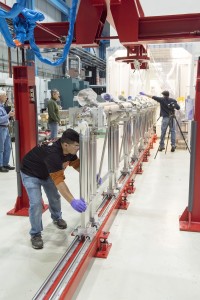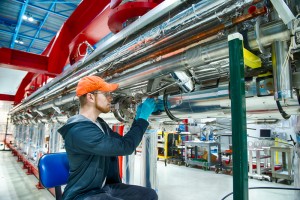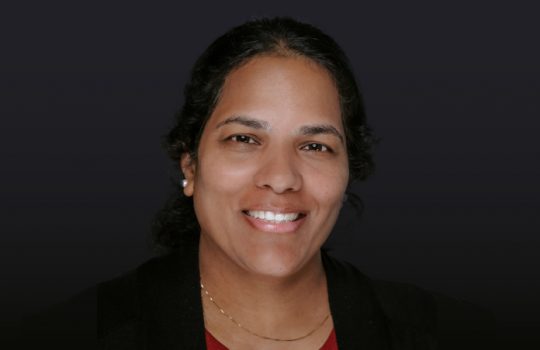
Members of the Fermilab Technical Division line up eight superconducting accelerator cavities to form a cavity string destined for SLAC National Accelerator Laboratory’s LCLS-II. Photo: Reidar Hahn
In February, a Fermilab team came together to witness a moment they’d looked forward to for over a year. Crew members parted the plastic sheeting at one end of a cleanroom and rolled out on narrow tracks a long string of eight accelerating cavities. It was the first cavity string for LCLS-II, which will greatly increase the power and capacity of SLAC’s Linac Coherent Light Source.
Accelerating cavities are structures that impart energy to a particle beam, and they’re the heart of the cryomodule — a major accelerator section — that Fermilab has designed and is building for LCLS-II.
“It’s a big deal. The cavity string’s all bolted up — it’s beautiful,” said SLAC scientist Marc Ross, LCLS-II cryogenics systems manager. “It’s a concrete step toward LCLS-II’s realization.”
SLAC’s LCLS-II is a powerful X-ray laser that will allow scientists to glimpse nature’s fundamental processes on an atomic level and ultrafast time scales. Today SLAC announced DOE approval of the start of construction for LCLS-II.
Since the rollout, the Fermilab team has been outfitting the cavity string with cooling equipment, instrumentation and structural support to form the cryomodule. By summer, they will have completed their first one.
“To me this is a major milestone because it shows that we can do it,” said Camille Ginsburg, the cryomodule team lead for the Fermilab LCLS-II effort. “It represents having tested all of those cavities successfully, finalized the design and put together all the assembly infrastructure that was required.”
The cryomodule is destined for LCLS-II’s new superconducting linear accelerator. Electrons speeding down the accelerator will generate an almost continuous X-ray laser beam with pulses of up to a million times per second — thousands of times faster than the current LCLS puts out. To be superconducting, the cryomodule’s cavities, made of niobium, must operate at minus 456 degrees Fahrenheit.
The linear accelerator backbone of LCLS-II comprises 37 cryomodules. Thomas Jefferson National Accelerator Facility in Virginia, another LCLS-II collaborating institution, will build 18 cryomodules of this type. Fermilab is building 17 of these cryomodules plus two that will operate at a higher frequency.

Andrew Penhollow of the Fermilab Technical Division tends to the LCLS-II prototype cavity string, which is seen here mounted to cooling infrastructure. Photo: Reidar Hahn
The boost from a pulsed beam to a continuous one means that the new accelerator will require much more power to operate. And with great power comes the need for great efficiency.
That’s why Fermilab scientists have, for the better part of a decade, been working on methods for building and treating cavities to be as efficient as they can be. By imparting maximum energy to the beam with minimal energy loss, efficient cavities help drive down the cost.
Last year, the Fermilab team reported a world-record quality factor, an indicator of the cavity’s efficiency in minimizing thermal losses.
“The performance of the individually tested cavities that were put into the string was far beyond anything that has been put into such a cryomodule before,” Ross said.
Fermilab also designed the cryomodule’s instrumentation to be able to handle the high power and its plumbing system to carry away heat.
“With continuous-wave operation, there’s a much higher heat load than there is with pulsed-beam acceleration, so everything has to be more robust,” said Fermilab’s Elvin Harms, who leads cryomodule testing for LCLS-II at Fermilab.
Scientists and engineers specially designed the couplers that transfer the radio-frequency power to the cavities with thicker, high-conductivity plating, for example, to carry away the high heat load.
The assembly process to this point has been painstaking, said Fermilab scientist Anna Grassellino, who is responsible for cavity preparation and testing for LCLS-II. And it promises to remain that way until the cryomodule is finally delivered to SLAC.
“Everything that’s happening now with the cryomodule assembly — every step is critical,” Grassellino said. “How you handle the parts can affect performance.”
Technicians who successfully assembled the first cavity string in the cleanroom spent two weeks carefully putting the components together. Following a protocol established at DESY in Germany and Saclay in France and borne out in tests at the Fermilab Accelerator Science and Technology facility, they moved in slow motion, since too-rapid movements would create particulates that could make their way into the cavity, degrading its operation in an accelerator.
“These techniques that seem ancillary are actually quite sophisticated,” Grassellino said. “When the cavity string was finished, it was, ‘Phew! Now it’s sealed, now it rolls out.’”
Crews are carefully installing shielding to protect the cavities from Earth’s magnetic field, which would ruin their performance; welding the cavity string to the plumbing for the super-cooled helium that will keep the cavities cold; and connecting everything structurally inside the vacuum vessel.
Cryomodule tests will begin early this summer. Fermilab and Jefferson Lab plan to move the completed cryomodules to SLAC toward the end of 2016.
“Congratulations to the entire cryomodule team here, at Jefferson Lab and at SLAC,” said Rich Stanek, Fermilab LCLS-II senior team leader. “We’re working hard to deliver cryomodules that meet or exceed specifications within the project cost and schedule.”
LCLS-II, like its predecessor LCLS, will be a DOE Office of Science User Facility.



